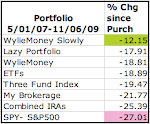The first thing that stands out is that to set up this portfolio you need a parent who has enough invested at Vanguard to waive the minimum requirements for each fund. So not any second grader could do this but second graders with parents who have some unspecified amount of wealth invested at Vanguard can do this.
Let's assume that not everybody has parents with huge investments at Vanguard but is looking for a way to begin investing. Does this approach still make sense? From what I can tell after poking around on Vanguard's site, this simple portfolio would be assessed a $30 annual fee until little Kevin's account was worth at least a quarter of a million dollars. In addition to that, each individual fund has another annual $10 fee until each holding is worth $10000.
So this lazy portfolio would cost $60 per year in fees. Now $60 is only a very small percentage of $9000 and these funds have very low expenses assessed within the funds themselves, but these fees make me mad anyway and should at least be mentioned.
Then, what really caught my eye was this chart which is terribly deceptive:
 The $3000 minimums listed do not represent the allocations used to calculate the actual returns. There is a column called "Allocation" that clarifies the actual allocation used to calculate the returns, but these allocations are not allowed in Vanguard funds to for the typical investor with this much to invest. So for those of us whose parents don't have their nest eggs socked away at Vanguard, this portfolio, with equal $3000 amounts invested in each fund, would have under performed the S&P 500 over a 1 year period, not out-performed it as listed. And the performance above the S&P over the 5 and 10 year periods would not have been as great and none of these returns factor in the $60 in annual fees. Again these fees are not huge but over 10 years they total $600. 1, 5, and 10 year annualized returns with equal weight in the 3 funds would have been: 15.45% 9.38% 7.44% -not shabby, but not what is listed.
The $3000 minimums listed do not represent the allocations used to calculate the actual returns. There is a column called "Allocation" that clarifies the actual allocation used to calculate the returns, but these allocations are not allowed in Vanguard funds to for the typical investor with this much to invest. So for those of us whose parents don't have their nest eggs socked away at Vanguard, this portfolio, with equal $3000 amounts invested in each fund, would have under performed the S&P 500 over a 1 year period, not out-performed it as listed. And the performance above the S&P over the 5 and 10 year periods would not have been as great and none of these returns factor in the $60 in annual fees. Again these fees are not huge but over 10 years they total $600. 1, 5, and 10 year annualized returns with equal weight in the 3 funds would have been: 15.45% 9.38% 7.44% -not shabby, but not what is listed.I do not want to be too critical of Mr. Farrell because I appreciate his approach in general: to advocate simple, diversified low cost portfolios that take very little management. But part of why I started my project was because none of the pundits writing about various methods for building portfolios actually ground their recommendations in the real world with portfolios you can really build with little money to start and with clarity about the fees.
What I am doing on my blog is using Etrade to propose a portfolio that you can actually buy, with $2500 minimums and no fee $100 monthly additions. Etrade has a $10,000 account minimum or an absurd $40 per quarter fee. So my hypothetical picks would not be good for someone with only $9,000 either. But if you have the $10,000 total, there is no individual fund fee or account fee in addition to this if you are using Etrade. The first four funds I recommend with $2500 minimums in each would total $10,000 but you should be sure and add a little more than this to avoid Etrade's absurd $160 annual fee in case these funds lose value in the short term.
I've written before about my issues with coming up with accurate statistics- indeed the chart above does not clarify if dividends are reinvested or not to achieve these averages. But I am going to show you the results of my picks according to the same source Mr. Farrell uses so you can compare:
 The lazy portfolio beat my hypothetical portfolio over the past year, but my portfolio come out ahead over 3 and 5 year periods. The Mid Cap Growth fund I recommended has not been around for 10 years so I cannot compare a total 10 year performance, but the other three funds I recommend have all outperformed every one of the Vanguard funds over 10 years.
The lazy portfolio beat my hypothetical portfolio over the past year, but my portfolio come out ahead over 3 and 5 year periods. The Mid Cap Growth fund I recommended has not been around for 10 years so I cannot compare a total 10 year performance, but the other three funds I recommend have all outperformed every one of the Vanguard funds over 10 years. My point in all of this is that it would be nice if people talking about how simple it is to invest would be clear about fees and minimums and use actual, possible scenarios that anyone can follow (at their own risk of course!).



No comments:
Post a Comment